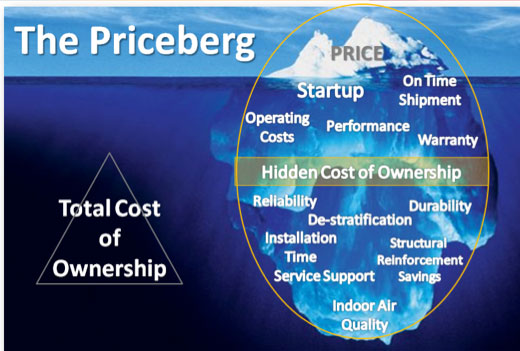
We are all consumers. We love the opportunity to get a great deal on a product that we value. Whether driven by a specific need or just a desire to improve our lives in some fashion, we want to make sure that we get the lowest price we possibly can balanced against the key value points we are trying to obtain. Without a clear definition of what is valued the most in a product purchase, cheap pricing carries little weight in evaluating our alternatives.
I happen to be a sales manager and a business developer for a U.S. based HVAC manufacturing firm that serves the North American new construction and energy retrofit markets. As you might imagine, there are a wide variety of options to choose from when selecting an HVAC system. The companies that I compete with have long-standing manufacturing histories, well developed relationships and varied product lines that meet very specific customer needs. With such a wide variety of options available, it becomes important to clearly define the bases for an HVAC equipment purchase decision:
- Base Line Minimum Requirements
- Value Added Requirements that can enhance a building’s performance and your relationship with the customer
- Value Added transformational elements that make life better
I would suggest to our end user, engineering and contractor customers that making the right decision on a commercial or industrial HVAC system starts with a thorough detailed list of what is most important prior to comparing price. Your list will allow for an apples to apples comparison of choices.
In our industry, we often hear that equipment pricing drives the decision-making process for contractors seeking a building project win. We know that equipment costs are typically one-third of the cost of a particular heating/ventilation system installation. Two-thirds of the total cost of install are typically wrapped up in installation, margin and risk assessment for a system installation. Comparing total system costs is not as easy when there are so many contributing factors.
Here is a list of key questions that may be helpful in fully understanding needs:
- How many distinct HVAC systems must be installed to meet a customer's needs?
- Heating
- Cooling
- Ventilation
- Destratification
- How many different pieces of equipment will need to be installed?
- How many gas lines must be run to serve each unit? How far?
- How many electrical runs are there to serve each unit? How far?
- How long does it take to install/startup each system? each unit? # of labor hours assigned?
- How many people are required for installation/startup?
- How reliable/durable is the equipment based on experience?
- How easy it is to obtain service support in the field?
- What is the length of the equipment warranty, the parts warranty?
- How important is on-time delivery for project management?
- How fast do you need the equipment on site?
- What are the lead times to meet deadlines and key hurdle dates in conjunction with other envelope installations, e.g. new roofing?
I would propose that total system value as opposed to first cost of equipment is more important in both the short and the long run. Avoiding the unseen costs that lurk below the surface (The Priceburg) of cheapest first cost often delivers a superior result to the customer/end user as well as the contractor. Contractors that desire to compete on their total value proposition with highly engaged manufacturing partners are more likely to build long-term successful relationships with clients.
The reason the statement “you get what you pay for” exists in our vernacular is because many have experienced the reality that cheapest can be the most expensive.
I would love to hear from you regarding your experiences with the lure of a manufacturer's “cheapest” claim and any resulting challenges.